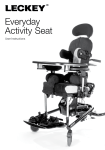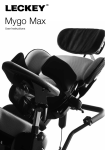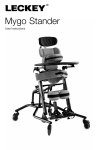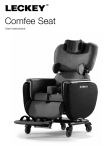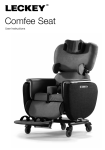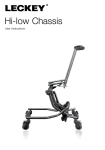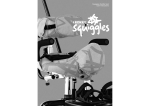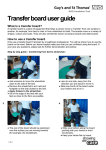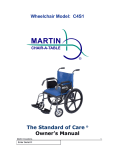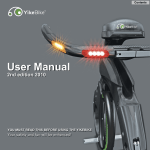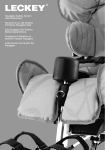Download Everyday Activity Seat User Instructions Assembly instructions
Transcript
Everyday Activity Seat User Instructions Assembly instructions Service manual The Everyday Activity Seat is a moderate seating system designed for use in the home and classroom. It comes in 3 sizes with adjustable seat height, depth and width to accommodate users from ages 1 to adult. This manual shows you how you can quickly and easily make use of all of the functions. The instructions on the safety and maintenance of the product will ensure that you will enjoy the use of this product for a long time. Contents 01 02 03 04 05 06 07 08 09 10 11 12 13 14 15 16 Intended use Declaration of conformity Terms of warranty Product history record Product Training Safety Information How to unpack and assemble Fitting the Covers Clinical setup for postural management Frequent adjustments for daily use Cleaning and Care Information Daily product inspection Annual Product Inspection Reissuing Leckey products Product servicing Technical Information 1. Intended Use The Everyday Activity Seat comes in 3 sizes catering for the needs of children with disabilities. Size 1 is for kids aged 1-6, size 2 is for 5-12 years, and size 3 is for 11-18 with a maximum user weight of 30kgs (110lbs), 50kgs (132lbs), and 100kgs (220lbs) respectively. 2. Declaration of Conformity James Leckey Design Ltd. as manufacturer with sole responsibility declares that the Leckey Everyday Activity Seat conforms to the requirements of the 93/42/EEC Guidelines and EN12182 Technical aids for disabled persons, general requirements and test methods. 3. Terms of Warranty The Warranty applies only when the product is used according to the specified conditions and for the intended purposes, following all manufacturer’s recommendations (also see general terms of sales, delivery and payment). A two year warranty is provided on all Leckey manufactured products and components. 4. Product History Record Your Leckey product is classified as a Class 1 Medical device and as such should only be prescribed, set up or reissued for use by a technically competent person who has been trained in the use of this product. Leckey recommend that a written record is maintained to provide details of all setups, reissue inspections and annual inspections of this product. 5. Product Training Record (Clients & Carers) Your Leckey product is a prescribed Class 1 Medical Device and as such Leckey recommend that parents, teachers and carers using the equipment should be made aware of the following sections of this user manual by a technically competent person. Section 6 Safety Information Section 9 Clinical Setup for postural management Section 10 Frequent adjustment for daily use Section 11 Cleaning & Care Information Section 12 Daily Product Inspection Leckey recommend that a written record is maintained of all those who have been trained in the correct use of this product. 6 Safety Information 6.1 Always read instructions fully before use. especially if there are children in the area. 6.2 Users should not be left unattended at any time whilst using Leckey equipment. 6.9 The Everyday Activity Seat is not a wheelchair and although mobility is an important feature of the seat we do not recommend that users be moved over uneven surfaces whilst in the equipment. All due care and attention should be taken if transporting the user from one seat to another. 6.3 Only use Leckey approved components with your product. Never modify the product in any way. Failure to follow instructions may put the user or carer at risk and will invalidate the warranty on the product. 6.4 If in any doubt as to the continued safe use of your product or if any parts should fail, please cease using the product and contact our customer services department or local dealer as soon as possible. 6.5 Carry out all positional adjustments and ensure that they are securely fastened before you put the user into this product. Some adjustments may require the use of a tool which is provided with each product. Keep all tools out of reach of children. 6.6 When placing the user into the seat, for safety reasons, always secure the pelvic harness first. 6.7 When the product is stationary ensure that all four castors are locked and facing away from the base. This is especially important when the tilt and space and back recline facility is in use. 6.8 When the seat is in use please ensure that the height adjustment pedal or bolts and tilt in space are locked off and cannot be adjusted accidentally, 6.10 The Everyday Activity Seat has not been crash tested therefore cannot be used in transport 6.11 Never leave the product on a sloping surface greater than 5 degrees. Always remember to lock all the castors. 6.12 Only use the push handle to steer and move the seat from one area to another. Never use the tray for this purpose. 6.13 The product contains components which could present a choking hazard to small children. Always check that locking knobs and bolts within the child’s reach are tightened and secure at all times. 6.14 Leckey products comply with fire safety regulations in accordance with EN12182. However the product contains plastic components and therefore should be kept away from all direct sources of heat including naked flames, cigarettes, electric and gas heaters. 6.15 Never place hot items on the Activity Tray as they may damage the plastic. 6.16 Clean the product regularly. Do not use abrasive cleaners. Carry out maintenance checks on a regular basis to ensure your product is in good working condition. 6.17 The product is designed for indoor use and when not in use should be stored in a dry place that is not subjected to extremes of temperature. The safe operating temperature range of the product is +5° to +40° Celsius. How to unpack and assemble Check parts Congratulations on purchasing your Everyday Activity Seat. All of the parts ordered will be contained in polythene bags with each one clearly labelled. Carefully remove them from the boxes and check all of the parts you have ordered. Keep polythene bags away from children. Multi Tool A number of adjustments will require the use of a multi tool, which is supplied with each seat. 7 7.1 Attaching the sandals 7.2 Attaching the armrests To attach the sandals simply unscrew the knob and washers from the sandal. Place the sandal onto the footplate positioning the screw through the slot and replacing the washers and knob. Repeat this for the other side. Insert the armrest into the receiving bracket and secure at the desired height by tightening the knob (a). A 7.3 Attaching the tray 7.4 Attaching the hip laterals The tray is attached to the seat by inserting the tray tubes through the centre of the armrest. Once the tray is located in position the knob (a) should be tightened securely. Unscrew the knob (a) from underneath the seat base. Place the hip lateral bracket onto the screw. Replace and tighten the knob. A A 7.5 Attaching the standard and flipaway chest lateral supports To attach the chest lateral supports, line the bracket up with the slots in the metal backrest. Insert the two allen key bolts through the small oval plate, then the backrest slot, and into the two sliding parts sitting in the bracket and tighten. To gain extra height with the laterals, take them off, turn them upside down, and reattach the left one on the right hand side of the back rest and vice versa. 7.6 Attaching shoulder protraction pads To attach the shoulder protraction pads, line up the bracket with the holes in the backrest and insert the three bolts and tighten. 7.7 Attaching the pommel 7.8 Attaching the footplate Insert the pommel bracket into the recess, insert the knob (a) and tighten. To attach the foot plate slide the footplate tube over the calf angle tube and tighten bolt (a). A A Fitting the Cushions 8 8.1 Backrest cushion The backrest cushion can be attached by simply setting it onto the backrest, then pressing down to locate the two snap fasteners at the top. Secure it to the Velcro on the backrest and loop the elastic over the hook. 8.2 Seat base cushion The seat base cushion can be attached by simply setting it in place, then pressing down to locate the snap fasteners (a) at the back of the seat base, next fold the cover underneath the front of the seat base and locate the snap fasteners (b). A B 8.3 Chest lateral support covers 8.4 Hip laterals To attach the chest lateral support covers, simply slide the covers on the lateral support. Feed the plastic buckle through the slot in the cover, then bring the two Velcro fastener straps around the bottom of the moulding and attach them to the Velcro panel as shown. Close over the strap. Slide the covers over the hip lateral hardware with the zip on the outside. Close the zip and the velcro. 8.5 Hip lateral bracket cover 8.6 Shoulder protraction pad covers Slide the cover around the bracket until it covers the angle adjustment mechanism, pull the tab over the top the angle adjustment and press the snap fastener. Slide the cover over the shoulder protraction assembly and secure using the zips. 8.7 Head support cover 8.8 Chest harness Place the cushion onto the head support. Snap the central fastener and two side fasteners in place. Bring the lower flap under the head support and attach the Velcro. The chest harness can be attached by clipping the male buckle (a) into the female buckle at either side of the lateral support. A 8.9 Pelvic harness With your pelvic harness you will receive four adjustable side straps, bolts, washers and locking nuts. The connecting straps should be attached to the chair at the points (a) and (b) on either side of the seat base. The pelvic harness can then be attached to the connecting straps by clipping the male buckles (c) into the female buckle on both sides of the seat base. To attach the harness in the correct orientation ensure the label on the inside is the correct way up. A C B 8.10 Trunk harness With your trunk harness you will receive two adjustable side straps, two shoulder straps, bolts, washers and locking nuts. Fix the connecting straps to the backrest before attaching the trunk harness. The straps are bolted to the backrest two at the top (a) and two at the bottom (b). Then connect the shoulder straps (c) into the clips at the top. A A C B B Clinical Setup for Postural Management The clinical setup of the product should be completed by a technically and clinically competent person who has been trained in the use of the product. Leckey recommend that a written record is maintained of all clinical setups for this product. Set the backrest height, seat depth and footplate height before placing the child in the seat. These can be fine tuned when the child is in the seat. 9 9.1 Pelvic harness 9.2 Hip laterals Before placing the user in the seat unclip the central plastic buckle and loosen the four straps to their maximum, making sure the straps are fed under the hip guides. Place the user in the seat and fasten the central buckle. To secure the user pull the two top straps towards you. Pull the two side straps up to fine tune the pelvic position and adjust the height of the pads on the pelvic girdle. Also depending on clothing worn the straps may need to be adjusted to suit. To adjust the width of the hip laterals loosen the knob (a) adjust to the required width and retighten. To adjust the depth, loosen the two allen bolts (b) with the multi tool provided, adjust to the required depth and retighten the allen bolts. The angle of the hip laterals can be adjusted by loosening allen bolt (c), adjusting to the required angle and retightening the bolt. B A C 9.3 Backrest Height The overall height of the backrest can be adjusted by loosening the two knobs, then positioning to the shoulder height of the user. Once in position the knobs should be retightened securely. The height can be fine tuned when the user is in the seat. When the height is lowered the cushion must be pulled around the bottom of the back rest and secured to the back of it via the Velcro and elastic tabs. Use caution when adjusting to minimum setting as fingers could become trapped between moving and static parts. 9.4 Backrest Angle The backrest can be angled by loosening the ratchet handle (a). Select the position you require the retighten the ratchet handle securely. Always ensure the back angle is secure to maintain the desired posture for the child. The backrest angle can be adjusted with the child in the seat, but always support the backrest with one hand. Always make sure the bolt is secure as this could cause injury to the child or carer. A 9.5 Seat depth 9.6 Footplate Height To adjust the seat depth simply loosen the knobs (a) on the underside of the seat base, pull the seat base towards you until the required seat depth has been achieved and tighten the knobs securely. To set the height of the footplate loosen the bolt (a) on the front of the calf support tube and slide the footplate to the required height and retighten the bolt. Always check the footplate is secure to prevent the user sliding forward and down in the seat which could pose a choking hazard if a chest or trunk harness is attached. A A 9.7 Footplate angle 9.8 Sacral support To set the angle of the footplate, loosen the ratchet handle (a) set to the required angle and retighten the handle. To adjust the height, loosen the bolts on either side with the multi tool provided. Adjust the support to the correct height and retighten the bolts. The footplate can simply flip up to aid transfer. A Always use caution to ensure fingers do not become trapped when adjusting the sacral support. 9.9 Chest Lateral supports 9.10 Chest harness Loosen the allen bolts (a) to adjust the width, height and angle of the lateral supports and retighten when you have achieved the desired position. To change the width of the chest harness. Lift the front cover, adjust the Velcro straps to the desired width and replace the cover. To move the flipaway laterals, use knob (b). A B 9.11 Trunk Harness 9.12 Sandals The trunk harness will be open but remain attached by side clip (a). When placing the child in the seating system bring the trunk harness across the front and attach by connecting the clip into the buckle on the other side (b). If your child is wearing outdoor clothing, the side straps can be opened by releasing the snap fasteners. All the connecting straps are adjustable by lifting the cover, adjusting to the desired length and replacing the cover. To position the sandals simply loosen the knob under the footplate, select the position required and refasten the knob. To position the user’s feet in the sandals secure the Velcro ankle and too straps provided. A B 9.13 Shoulder support 9.14 Head support To adjust the height of the shoulder support, loosen the allen bolts, adjust to the required height and retighten the bolts. To adjust the height and depth of the contoured headrest, loosen the hand knobs (a) and when set to the desired position retighten the knobs. Do not remove the head support while the user is in the seat. Never use the head support to force the position of the user’s head. Always use caution to ensure fingers do not become trapped when adjusting the head support. A 9.15 Armrest adjustment To adjust the height of the armrest loosen the hand knob (a), set to the desired height and retighten. To adjust the angle, rotate ratchet handle (b) until the desired position has been achieved. B A 9.16 Tray adjustment The height and angle of the tray are set by adjusting the armrests as detailed above. To remove or adjust the depth of the tray loosen the knobs (a) under the armrest, set to the desired position and retighten securely. Always use caution to ensure the child’s hands or arms do not become trapped when inserting the tray. Never use the tray to steer or push the chair. Do not place objects, hotter than 40 degrees Celcsius on the tray. Please note that the tray is for the use of the user only. Do not lean or place objects on the tray, greater than 8kgs (17.6lbs). A Frequent adjustment for daily use (therapists/ carers/parents) Parents and carers should be shown how to make frequent adjustments and be made aware of the safety checks in Section 6 by a technically and clinically competent person who has been trained in the use of the product. Leckey recommend that a written record is maintained of all parent and carers who have been trained in the use of this product. 10 10.1 Transferring your child into and out of the seat 10.2 Adjusting the pelvic harness Before transferring the child into the seat carry out the daily product inspection as outlined in section 13 of this user manual. The correct positioning and tensioning of the pelvic harness is key to a child’s postural management, affecting their comfort and ability to carry out activities. Please consult with your therapist to ensure the harness is positioned correctly and that the straps are tensioned appropriately. Adjust the seat to a comfortable height to facilitate transfer. Lock all the castors, ensuring that they are facing outwards to maximise product stability. Make sure the safety buckle on the chest harness is released and is out of the way to facilitate transfer. If the seat has flip-away chest laterals, first move these out of the way. Unclip the pelvic harness in the middle. Lastly if sandals are fitted open the straps. You are now ready to transfer or hoist the child into the seat. To tension the pelvic harness straps and pads around the child pull the centre strap (a). Pull the two side straps up to fine tune the pelvic position and adjust (b) the height of the pads on the hips. If using the seat outdoors and your child is wearing a coat, position the pelvic harness under the coat. Once the child is in the seat, firstly fasten the pelvic harness using the middle buckle. Then refasten the sandal straps and any other harnesses, and reposition the chest laterals. Always secure the pelvic harness or Pelvic Cradle first before fastening other buckles or harnesses. Adjust the harness so the child cannot slide or creep forward in the seat. B A 10.3 Chest and Trunk Harness Adjustment If the child requires chest support as part of their postural support programme the seat will be fitted with rigid laterals or a combination of laterals, chest harness and trunk harness. These may need to be adjusted on a daily basis to accommodate differences in clothing. Always check with your therapist as to the optimum positioning and tensioning of the straps and support items for the child. To change the width of the chest harness, lift the front cover, adjust the Velcro straps and set to the desired width. When the correct width has been achieved replace the cover. Please refer to section 9 for specific guidance on adjusting the trunk harness. Always make sure the plastic buckles are fully engaged when using the chest harness. Check the harness and laterals are secure to ensure the child is safe and cannot slide forward in the seat as this may restrict their breathing. If the child is active or has extensor spasms check the pelvic harness is secure after each spasm to ensure the child is safe and cannot slide forward in the seat. Always fasten the centre buckle on the pelvic harness before making any other adjustments. 10.4 Chassis 10.5 Height Adjustment – Hi-low chassis The Everyday Activity Seat is designed to fit onto one of two chassis options. This user manual shows the correct and safe use of the seating system with these chassis options. You can carry out this adjustment with the child in the chair. To adjust the height of the Hi-low chassis press the foot lever at the rear of the chassis whilst holding the push handle. Once you remove your foot from the pedal the seat will be fixed at the chosen height. The castors on the chassis include directional locks. To apply the locks push down on the grey pedal. When the directional locks are in use the chair will steer with the back castors. For safety the height adjustment pedal on the chassis can be locked by engaging the pull pin (a) on the right hand side of the pedal. To unlock pull the pin out and rotate 90 degrees, the pedal can then be operated. The locking pin (a) should be kept in the locked position when you are not adjusting the chassis. Always keep the locking pin engaged when you are not adjusting the chassis. This will prevent the foot pedal being operated accidentally. 10.6 Height Adjustment – Basic chassis For children over the weight of 27kg (60lbs), raising the Hi low chassis is a 2 person lift (UK lifting and handling regulations). Always use caution as hands could become trapped when height adjusting the base. The height of the Basic Chassis should be set before putting the child in the seat. To adjust the height loosen the ratchet handle (a) at the rear of the main stem and adjust the seat to the required height. To lower the seat height, apply weight centrally on the seat base above the centre stem. Retighten the ratchet handle to secure. Check the ratchet handle regularly to ensure the seat height adjustment is secure. Do not height adjust with the child in the seat. A A 10.7 Tilt in Space The tilt in space can be angled while the user is in the seat. Before you adjust the tilt in space angle of the seat always ensure the pelvic harness is secured preventing the user from sliding forward in the seat. To adjust the tilt angle press the lever under the seat base. Once you have selected the angle you require, by simply removing your hand from the lever, the chair will be locked in position. The tilt in space should be locked off while the user is in the seat. To lock the lever twist the pull pin to the right hand side of the lever and the pin will pop into position. You may have to lift the lever slightly to allow it to lock. To unlock pull the pin out and rotate 90 degrees, the lever can then be operated. Always keep the tilt in space lever in the locked position to prevent accidental actuation of the lever which could cause the seat unit to jolt and possibly cause injury to the child. Please use handle bars when operating tilt in space. Always check with your therapist that the use of tilt in space will not cause any obstructions to the child’s airways. Always keep a tight grip on handle bar with one hand when opening the lever. 10.8 Sandals 10.9 Tray adjustment To position the user’s feet in the sandals secure the Velcro straps provided so the foot is held in place. The straps should be placed over the bridge of the foot and over the toes. The tray can be used for a range of functions and its position can be fine tuned to suit the user and the activity whether it is for fun, education or feeding. The tray is attached to the seat by inserting the tray tubes through the centre of the armrest. Once the tray is located in the position the knob (a) should be tightened securely. If the child is wearing sandals or light footwear check the straps to make sure the webbing does not irritate the skin. Adjust the armrests to set the height and angle of the tray. Always use caution as fingers could become trapped in the slot when adjusting the height. Always use caution to ensure the child’s hands or arms do not become trapped when inserting the tray. Never use the tray to steer or push the chair. Do not place hot objects, greater than 40 degrees Celsius on the tray. A 10.9 Armrest adjustment Please note that the tray is for the use of the user only. Do not lean or place heavy objects on the tray, not greater than 8kgs (17.6lbs). To adjust the height of the armrest loosen the hand knob (a) set to the desired height and retighten. To adjust the angle rotate ratchet handle (b) until the desired position has been achieved. A B 11 Cleaning & Care Information How to Maintain When cleaning we recommend that you use only warm water and a non-abrasive detergent. Never use organic solvents or dry cleaning fluids. Upholstery and fabrics 1. The cushion covers can be removed, machine washed at 40ºC and tumble dried at a low temperature. Please remove the foam from the following covers before washing: Headrest Backrest cushion Seat base cushion Shoulder protraction pad covers All other soft upholstery can be placed into the washing machine intact, after removing bolts and fastenings. 2. The upholstery and fabrics can also be cleaned by hand whilst in place. When cleaning we recommend that you use only warm water and a non-abrasive detergent. 3. Staining should be removed as quickly as possible with absorbent cloth, towels or a sponge. Routine soap and warm water sponging is effective for ordinary soiling and minor spills. Be careful not to over wet the fabric as this will cause the staining to spread. 4 Antiseptic cleaning agents can be used on more stubborn stains. These may require a safe solvent such as Isopropyl Alcohol or Mineral Spirit. A half cup of household bleach to 5 litres of water can also be used as a useful disinfectant. 5. The pelvic and trunk harnesses can be machine washed at 40 Deg C. Make sure all bolts and fasteners are removed first as they may cause damage to your washing machine. Store these in a safe place and out of reach from children. 6 Always ensure the product is dry before use. Metal and plastic components 1. Soap and water or antibacterial spray can be used for daily cleaning. 2. For deep cleaning a low pressure steam cleaner can be used. 3. Do not use solvents to clean plastic or metal components. 4. Make sure the product is dry before use. 12 Daily Product Inspection (Therapists, Parents & Carers) We recommend that daily visual checks of the equipment are carried out by therapists, carers or parents to ensure the product is safe for use. The recommended daily checks are detailed below. 1. Ensure all adjustment knobs and bolts are in place and secure. 2. Check all upholstery and Velcro for signs of wear and tear. 3. Check all castors are moving freely and lock securely. 4. Ensure the handle and locking pin on the seat interface plate is fully engaged and the seat unit is securely fixed onto the chassis. 5. Ensure the pelvic harness is fully secured around the user and they cannot slide or creep forward in the seat. 6. Ensure the footplate is attached securely. If in any doubt to the continued safe use of your Leckey product or if any parts should fail, please cease using the product and contact our customer service department or your local dealer as soon as possible. 13 Annual Product Inspection (Therapist, Technician, Leckey Product Advisor, Dealer) Leckey recommend that each product should be subject to a detailed inspection at least once a year and every time the product is reissued for use. This inspection should be carried out by a technically competent person who has been trained in the use of the product and should include the following checks as a minimum requirement. 1. Check all ratchet handles, knobs, nuts, bolts and plastic buckles are in place, replacing any missing items. Paying particular attention to the following items; > Headsupport locking bolts. > Backrest height and angle adjustments bolts. > Seat depth adjustment bolts. > Pelvic harness / hip guide attachment bolts. > Footrest height and angle adjustment. 2. Check the chassis height adjustment mechanism is working properly. If the chassis is foot pedal operated ensure the seat height doesn’t change when the pedal is released. Also, check that the locking pin engages securely to prevent accidental height adjustment of the chassis. 3. Adjust the seat to its maximum range of tilt in space and ensure that the locking lever locks the seat out securely at varying point in this range. 4. Check that where the seat and chassis join there is no visible wear and tear on the metal components. 5. Lift the base to check each castor individually. Make sure they are moving freely and remove any dirt from the rubber wheels. Check that the brakes lock the wheels securely. 6. Visually check the structure of the product paying attention to weld points on the frame ensuring there are no signs of fatigue or cracking around the welds. 7. Leckey recommend that a written record is maintained of all annual product inspections. If in any doubt to the continued safe use of your Leckey product or if any parts should fail, please cease using the product and contact our customer service department or your local dealer as soon as possible. 14 Re-issuing Leckey Products Most Leckey products are assessed and ordered to meet the needs of an individual user. Before reissuing a product we recommend that the therapist prescribing the product has carried out an equipment compatibility check for the new user and has ensured that the product being re-issued contains no modifications or special attachments. A detailed technical inspection should be carried out on the product prior to re-issuing. This should be carried out by a technically competent person who has been trained in the use and inspection of the product. Please refer to section 13 for the required checks to be carried out. Ensure the product has been cleaned thoroughly in accordance with section 11 of this manual. Ensure a copy of the user manual is supplied with the product. A copy can be downloaded from our website www.leckey.com Leckey recommend that a written record is maintained of all product inspections carried out during the reissue of the product. If in any doubt to the continued safe use of your Leckey product or if any parts should fail, please cease using the product and contact our customer service department or your local dealer as soon as possible. 15 Product Servicing Servicing of all Leckey products should only be carried out by technically competent persons who have been trained in the use of the product. In the UK & ROI please contact the Leckey Service Centre on UK 0800 318265 or ROI 1800 626020 and our customer service department will be delighted to assist you with your servicing requirements. All international service enquiries should be directed to the appropriate Leckey distributor who will be delighted to assist you. For further information on Leckey distributors please visit our website www.leckey.com 16 Technical Information Size 1 2 3 Age 1-6 5-12 11-18 mm/kg inches/lbs mm/kg inches/lbs mm/kg inches/lbs Max load 30kgs 66lbs 50kg 110lbs 100Kgs 220lbs Weight - seat and basic chassis 22.5kg 50lbs 27kg 60lbs 29kg 64lbs Weight - seat and hi-low chassis 29.5kg 65lbs 34kg 75lbs n/a Seat height – basic chassis 450-600 17.7-23.6 450-600 17.7-23.6 450-600 Seat height – hi-low chassis 250-600 9.8-23.6 320-600 12.6-23.6 n/a Seat width 160-280 6.3-11 260-380 10.2-15 340-440 13.4-17.3 Seat depth 150-280 5.9-11 230-380 9-15 330-480 13-18.9 Lateral distance 150-220 5.9-8.7 170-240 6.7-9.4 240-300 9.4-11.8 Back height 300-400 11.8-15.7 400-520 15.7-20.5 450-600 17.7-23.6 Back angle 30° supine 10° prone Armrest height 150-250 5.9-9.8 150-250 5.9-9.8 180-325 7-12.7 Lower leg length - basic chassis 150-250 5.9-9.8 280-450 11-17.7 280-450 11-17.7 Lower leg length - hi-low chassis 150-250 5.9-9.8 280-450 11-17.7 n/a Lower leg angle -10° to +50° -10° to +50° -10° to +50° Foot plate angle -15° to +10° -15° to +10° -15° to +10° Tilt-in-space 25º supine 10º prone 25º supine 10º prone 25º supine 10º prone All international service enquiries should be directed to the appropriate Leckey distributor who will be delighted to assist you. For further information on Leckey distributors please visit our website. www.leckey.com. 17.7-23.6 30° supine 10° prone 30° supine 10° prone Accessories 151-1741 151-2742 151-1742 151-2741 151-3741 Size 1 seat base, 100mm castors Size 2 seat base, 100mm castors Size 1 seat base, 100mm castors Size 2 seat base, 100mm castors Size 3 seat base, 100mm castors 151-1744-01 151-2744-01 151-3744-01 151-1744-03 151-2744-03 151-3744-03 151-1744-04 151-2744-04 151-3744-04 Size 1 cushions Size 2 cushions Size 3 cushions Size 1 cushions Size 2 cushions Size 3 cushions Size 1 cushions Size 2 cushions Size 3 cushions 151-1751 151-2751 Small contoured headrest hardware and cover - grey Contoured headrest hardware and cover - grey 151-1756 Mygo headrest attachment bracket 151-1753 120-893-15 Flat headrest hardware and cover - grey Flat headrest laterals assembly & covers 151-1637 151-3637 151-1639 151-3639 Size 1 and 2 Rigid PU chest laterals (Grey cover included) Size 3 Rigid PU chest laterals (Grey cover included) Size 1 and 2 flip away PU chest laterals (Grey cover included) Size 3 Flip away PU chest laterals (Grey cover included) 151-1758 151-3758 151-1757 151-3757 151-1748 151-3748 137-808-15 Size Size Size Size Size Size Size 120-799 120-757 117-761 117-750 Small trunk harness (MYGO) Medium trunk harness (MYGO) Large trunk harness (MYGO) Harness extension strap (10cm) backrest and basic chassis with gas spring and backrest and hi-low chassis with gas spring and backrest, and hi-low chassis with gas spring and backrest and basic chassis with gas spring and backrest and basic chassis with gas spring and and covers - green and covers - green and covers - green and covers - blue and covers - blue and covers - blue and covers - pink and covers - pink and covers - pink 1 and 2 Basic chest laterals (Grey cover included) 3 Basic chest laterals (Grey cover included) 1 and 2 Complex flipaway laterals 3 Complex flipaway laterals 1 and 2 Protraction Pad (Grey cover included) 3 Protraction Pad (Grey cover included) 1,2 & 3 chest harness ((Grey cover included) 151-1754 151-2754 151-3754 Size 1 side pads (pair - hardware only) Size 2 side pads (pair - hardware only) Size 3 side pads (pair - hardware only) 151-1750-15 151-2750-15 151-3750-15 Size 1 side pads cover (grey) Size 2 side pads cover (grey) Size 3 side pads cover (grey) 151-1650 151-2650 Size 1 pommel Size 2 and 3 pommel 151-1644 151-2644 151-3644 Size 1 tray plastic Size 2 tray plastic Size 3 tray plastic 151-1643 151-2643 151-3643 Size 1 tray wooden Size 2 tray wooden Size 3 tray wooden 151-1747 151-2747 151-3747 Size 1 armrests Size 2 armrests Size 3 armrests CAS/1/154 CAS/2/154 CAS/3/154 Size 1 -4 point pelvic belt Size 2 -4 point pelvic belt Size 3 -4 point pelvic belt 151-1745 151-2745 151-3745 Size 1 one piece footplate - metal Size 2 one piece footplate - metal Size 3 one piece footplate - metal 151-1746 151-2746 151-3746 Size 1 one piece footplate - wooden Size 2 one piece footplate - wooden Size 3 one piece footplate - wooden 117-1781 117-2781 117-3781 117-787 Size 1 sandals, incl straps Size 2 sandals, incl straps Size 3 sandals, incl strap 1” Sandal raiser (1 off) 151-1755 151-2755 151-3755 Size 1 footplate straps Size 2 footplate straps Size 3 footplate straps 151-1744-14 151-2744-14 151-3744-14 Size 1 incontinence seatbase cover - black Size 2 incontinence seatbase cover - black Size 3 incontinence seatbase cover - black
















































